| |
Diet Associations With Nonalcoholic Fatty Liver Disease
in an Ethnically Diverse Population: The Multiethnic Cohort
|
| |
| |
Download the PDF here
Download the PDF here
.....this study found differences between ethnic groups regarding affects of these factors on NAFLD and liver disease.
[red meat, cholesterol, poultry, fruits, high fiber diets, vegetables, mediterranean diet - all associated in this or previous studies with fatty liver & liver disease.]
Hepatology June 2020
Epidemiological data on dietary risk factors for nonalcoholic fatty liver disease (NAFLD) from populationâ€based studies, particularly in an ethnically diverse population, are scarce. We examined dietary factors in relation to NAFLD risk in African Americans, Japanese Americans, Latinos, native Hawaiians, and whites in the Multiethnic Cohort (MEC).
Nonalcoholic fatty liver disease (NAFLD) has an estimated global prevalence of 25.3%1 and is the most common chronic liver disease.2 NAFLD represents a spectrum of disease severity, ranging from benign simple steatosis, termed “nonalcoholic fatty liver,†to nonalcoholic steatohepatitis (NASH), which may lead to cirrhosis, hepatocellular carcinoma (HCC), and liver decompensation.3-5 A key step in the pathogenesis of NAFLD is the development of insulin resistance,6 a condition related to excess body fat that occurs primarily in the liver, muscle, and adipose tissue.7 The association of insulin resistance and obesity with NAFLD highlights the importance of excess energy intake. However, diet composition can also contribute to the development of insulin resistance and NAFLD.
Two recent studies showed that high consumption of red and/or processed meat was associated with a greater risk for NAFLD and insulin resistance in a crossâ€sectional study of population attending a gastroenterology department for screening8 and that high animal protein intake, pointing at meat, was a risk factor for NAFLD in an aging white population.9 Other studies including ours have shown that diet quality10-12 and specific foods or nutrients, such as coffee,13 sugarâ€sweetened beverages,14, 15 and saturated fat,16 are associated with NAFLD. However, large populationâ€based studies of diet and NAFLD associations, particularly in diverse ethnic groups and highâ€risk minority populations, are lacking. To address this gap, we performed a comprehensive analysis of dietary risk factors for NAFLD overall and by cirrhosis status in African Americans, native Hawaiians, Japanese Americans, Latinos, and whites in the Multiethnic Cohort Study (MEC).
Associations of Diet With NAFLD by Race/Ethnicity
The race/ethnicityâ€specific results are shown in Supporting Table S1. The associations with NAFLD were generally similar across racial/ethnic groups, except for poultry consumption (P heterogeneity = 0.004). The significant positive association between poultry and NAFLD was observed for whites (P trend = 0.003) and native Hawaiians (P trend = 0.005) only. The associations of red meat and processed red meat with NAFLD were in a similar direction across racial/ethnic groups but were only statistically significant in whites (total red meat P trend = 0.005, processed red meat P trend = 0.005) and in Latinos (processed red meat P trend = 0.022). Cholesterol was significantly positively associated with NAFLD in whites (P trend = 0.006) and native Hawaiians (P trend = 0.036), while fiber intake was significantly inversely associated with NAFLD in whites (P trend = 0.028) and Latinos (P trend = 0.034).
red meat, cholesterol, poultry, fruits, high fiber diets, vegetables, mediterranean diet - all associated with fatty liver & liver disease.
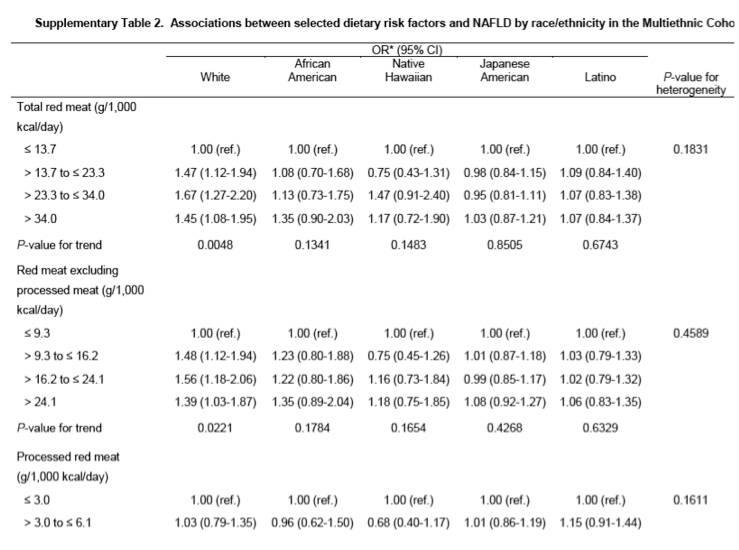
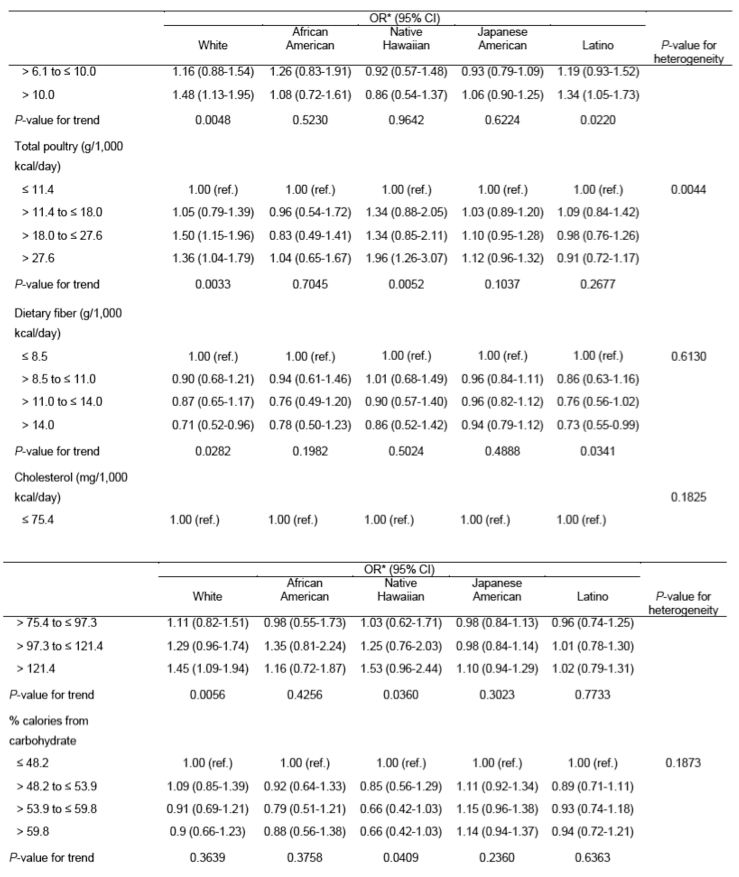
-----------------------------
Lifestyle change, including dietary habits and physical activity, are and should be the first line treatment in NAFLD and NASH. Weight reduction is the most established treatment for both NAFLD and NASH, with a clear dose-response association. "Weight reductions of ≥ 10% are required for inducing NASH resolution (reaching 90% of patients who achieved this weight reduction) or improving fibrosis by at least one stage (81%).http://www.natap.org/2017/HCV/052617_03.htm
Mediterranean/Low Carb Diet Superior in Reducing Hepatic
Fat for Fatty Liver/NAFLD & Non-NAFLD too.....http://www.natap.org/2019/HIV/051619_01.htm The beneficial effect of Mediterranean diet over the low-fat diet is mainly mediated by decreases in hepatic fat rather than visceral fat loss. Compared to the LF diet, MED/LC diet induced a greater increase in HDL-c (3.3±7.5 vs. 5.6±7.1 mg/dl), and a more pronounced decrease in diastolic BP (1.2±10.1 vs. -1.9±7.5 mmHg), triglycerides (-3.4±43.7 vs. -10.8±28.0 mg/dl), TG/HDL ratio (-0.15±0.4 vs. -0.23±0.4) and cardiovascular risk.
Fatty Diets May Lead to Cirrhosis....http://www.natap.org/2005/HCV/050905_02.htm "...NAFLD (fat accumulation in the liver) patients treated with insulin-sensitizing agents show marked improvement in their condition.."....."....potential sources of fats contributing to fatty liver....include peripheral fats stored in adipose tissue that flow to the liver...and dietary fatty acids..."
A low-carbohydrate diet rapidly and dramatically reduces intrahepatic triglyceride content....http://www.natap.org/2006/HCV/080106_02.htm
EASL 2019 - LIFESTYLE FOR THE TREATMENT OF NON-ALCOHOLIC FATTY LIVER DISEASE http://www.natap.org/2019/EASL/EASL_89.htm
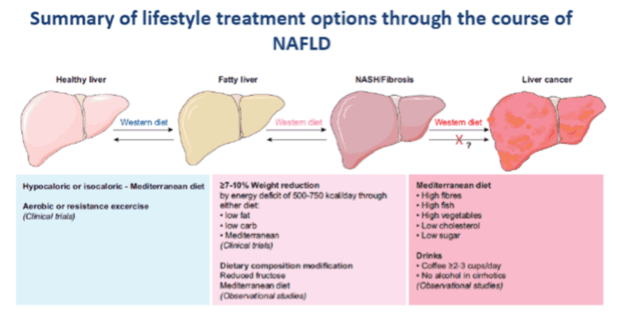
---------------------------------
Hepatology June 2020 - Mazen Noureddin,1,2 Shira Zelber-Sagi,3 Lynne R. Wilkens,4 Jacqueline Porcel,5 Carol J. Boushey,4 Loïc Le Marchand,4
Hugo R. Rosen,6 and Veronica Wendy Setiawan
The study consisted of 2,974 NAFLD cases (518 with cirrhosis, 2,456 without cirrhosis) and 29,474 matched controls. Red meat (P trend = 0.010), processed red meat (P trend = 0.004), poultry (P trend = 0.005), and cholesterol (P trend = 0.005) intakes were positively associated with NAFLD, while dietary fiber intake (P trend = 0.003) was inversely associated with risk. Stronger associations were observed between red meat and cholesterol and NAFLD with cirrhosis than without cirrhosis (P heterogeneity ≤0.014).
Dietary recommendations remain the first step and cornerstone of NAFLD/NASH treatment. Our findings suggest that diets low in meat and cholesterol and high in fiber may reduce the risk for NAFLD and for related advanced liver disease. Finally, our study calls for detailed nutrient documentation in future NASH trials, especially those with long followâ€up duration (phases 3 and 4) as diet may influence disease progression and study results.
In this large populationâ€based study of ethnically diverse populations in the United States, we assessed various dietary factors in relation to NAFLD and NAFLDâ€related cirrhosis. We found thathigher intakes of red meat, processed red meat, poultry, and cholesterol are risk factors for NAFLD, while dietary fiber is a protective factor. Importantly, the associations were generally similar across a wide spectrum of racial/ethnic groups, supporting the external validity of the observed associations. Moreover, certain dietary risk factors (i.e., red meat and cholesterol) were associated with NAFLDâ€related cirrhosis.
Interestingly, we found that poultry intake was also associated with NAFLD risk. Most previous studies did not specifically examine poultry consumption as most focused on overall meat consumption or red and processed meat consumption. In a smaller case–control study of 280 Italians, Miele et al. demonstrated that a high consumption of white meat was associated with increased risk of NAFLD.22
The association between meat intake, particularly red and processed meat, and NAFLD risk is not unexpected. Both have shown associations with diabetes, cardiovascular diseases, insulin resistance, CLD, and HCC.23-25 Freedman et al. showed that red meat is associated with risk of CLD and HCC, both of which may lead to or emerge with cirrhosis progression.25 The harmful effect of red meat has been partially attributed to the formation of heterocyclic aromatic amines (HAAs) during less healthy cooking methods such as frying and barbecuing to a level of very well done. HAAs have been shown to increase oxidative stress, which is a key step in the pathophysiology of NASH and ultimately cirrhosis.26-28 Collectively, these findings highlight the possible harmful effects of red meat and their association with NAFLD. Indeed, the Mediterranean diet, which is low in red meat and processed red meat, was found to be beneficial in NAFLD, leading to decreased steatosis and improved insulin resistance.11, 29 In a recent prospective study of diet quality and NAFLD by genetic risk score, red meat was implicated as one of the driving components for the association between diet quality and changes in liver fat.12
In our study, we found an inverse association between total dietary fiber and NAFLD. Only few, smaller observational studies reported that patients with NAFLD consume fewer vegetables and less dietary fiber than controls.30, 31 Randomized intervention studies have shown that fiber intake improves liver enzymes and noninvasive NAFLD scores among participants with NAFLD.32, 33 We found a significant inverse trend between fruit intake and NAFLD, and a previous study showed that fiber from fruits has a favorable effect on liver enzymes among obese individuals.33 While it has been suggested that a highâ€fiber diet could have a preventive role in liver diseases, and indeed high fiber intake is one of the plausible molecular mechanisms for the beneficial effect of the Mediterranean diet in NAFLD,21, 34 more studies are warranted to confirm our findings and support this recommendation.
Although total fat and fat composition were not associated with NAFLD, cholesterol consumption was associated with NAFLD risk in our study. It is interesting to note that the association was mainly observed for NAFLD with cirrhosis. A prospective analysis using National Health and Nutrition Examination Survey data (5â€year followâ€up, 123 cases with cirrhosis among 9,221 participants) showed similar findings; while total fat consumption was not associated with the risk of cirrhosis, cholesterol consumption was associated with higher risk.35 Dietary cholesterol is suggested to be an important risk factor for the progression to hepatic inflammation in dietâ€induced NASH.36 However, the role of cholesterol and the severity of NAFLD have been established mostly in animal models and less consistently in human studies. A diet of normalâ€weight patients with NASH compared to ageâ€matched, genderâ€matched, and BMIâ€matched controls was richer in cholesterol37; and a similar finding was seen in the diet of normalâ€weight patients with NAFLD compared to patients with obesity and NAFLD.38 Previous epidemiological studies, however, did not demonstrate an association between cholesterol intake and NAFLD.9, 14 Min et al. showed that 3â€hydroxyâ€3â€methylâ€glutarylâ€coenzyme A reductase expression was correlated with free cholesterol, lowâ€density lipoprotein cholesterol, and histologic severity of NAFLD.39 Their data revealed that dysregulated cholesterol metabolism in human NAFLD may contribute to disease severity. In animal models, cholesterolâ€rich diets have led to oxidative stress and progression from NAFLD to NASH.40, 41 Others have shown that mitochondrial free cholesterol loading (but not fatty acids or triglycerides) leads to mice being sensitized to tumor necrosis factor–induced and Fasâ€induced steatohepatitis.42 Studies in mice have also shown that free cholesterol accumulates in hepatic stellate cells and that a highâ€cholesterol diet aggravates liver fibrosis.43, 44 Altogether, these studies support our finding of an association between dietary cholesterol and NAFLD severity.
Abstract
Background and Aims
Epidemiological data on dietary risk factors for nonalcoholic fatty liver disease (NAFLD) from populationâ€based studies, particularly in an ethnically diverse population, are scarce. We examined dietary factors in relation to NAFLD risk in African Americans, Japanese Americans, Latinos, native Hawaiians, and whites in the Multiethnic Cohort (MEC).
Approach and Results
A nested case–control analysis was conducted within the MEC, a large prospective study with >215,000 older adult participants in Hawaii and California. NAFLD was identified using Medicare claims data, and controls were selected among participants without liver disease and individually matched to cases by birth year, sex, ethnicity, and length of Medicare enrollment. Diet was assessed at baseline through a validated quantitative food frequency questionnaire. Diet–NAFLD associations were quantified by odds ratios and 95% confidence intervals using multivariable conditional logistic regression. The study consisted of 2,974 NAFLD cases (518 with cirrhosis, 2,456 without cirrhosis) and 29,474 matched controls. Red meat (P trend = 0.010), processed red meat (P trend = 0.004), poultry (P trend = 0.005), and cholesterol (P trend = 0.005) intakes were positively associated with NAFLD, while dietary fiber intake (P trend = 0.003) was inversely associated with risk. Stronger associations were observed between red meat and cholesterol and NAFLD with cirrhosis than without cirrhosis (P heterogeneity ≤0.014).
Conclusions
Dietary factors are independently associated with NAFLD and NAFLDâ€related cirrhosis in a multiethnic population. Decreasing the consumption of cholesterol, red and processed meat, and poultry and increasing consumption of fiber may reduce the risk for NAFLD and related advanced liver disease.
Nonalcoholic fatty liver disease (NAFLD) has an estimated global prevalence of 25.3%1 and is the most common chronic liver disease.2 NAFLD represents a spectrum of disease severity, ranging from benign simple steatosis, termed “nonalcoholic fatty liver,†to nonalcoholic steatohepatitis (NASH), which may lead to cirrhosis, hepatocellular carcinoma (HCC), and liver decompensation.3-5 A key step in the pathogenesis of NAFLD is the development of insulin resistance,6 a condition related to excess body fat that occurs primarily in the liver, muscle, and adipose tissue.7 The association of insulin resistance and obesity with NAFLD highlights the importance of excess energy intake. However, diet composition can also contribute to the development of insulin resistance and NAFLD.
Two recent studies showed that high consumption of red and/or processed meat was associated with a greater risk for NAFLD and insulin resistance in a crossâ€sectional study of population attending a gastroenterology department for screening8 and that high animal protein intake, pointing at meat, was a risk factor for NAFLD in an aging white population.9 Other studies including ours have shown that diet quality10-12 and specific foods or nutrients, such as coffee,13 sugarâ€sweetened beverages,14, 15 and saturated fat,16 are associated with NAFLD. However, large populationâ€based studies of diet and NAFLD associations, particularly in diverse ethnic groups and highâ€risk minority populations, are lacking. To address this gap, we performed a comprehensive analysis of dietary risk factors for NAFLD overall and by cirrhosis status in African Americans, native Hawaiians, Japanese Americans, Latinos, and whites in the Multiethnic Cohort Study (MEC).
Associations of Meat, Vegetable, and Fruit Intakes With NAFLD
The BMIâ€adjusted and lifestyleâ€adjusted associations of meat intakes with NAFLD are shown in Table 2. Total red meat (OR quartile 4 versus quartile 1, 1.15; 95% CI, 1.02â€1.29; P trend = 0.016), red meat excluding processed red meat (OR, 1.16; 95% CI, 1.04â€1.30; P trend = 0.010), and processed red meat (OR, 1.18; 95% CI, 1.05â€1.32; P trend = 0.004) were associated with NAFLD. Total poultry intake was also associated with NAFLD (OR, 1.16; 95% CI, 1.04â€1.30; P trend = 0.005), as was processed poultry intake (OR, 1.12; 95% CI, 1.01â€1.24), although the trend was not statistically significant (P trend = 0.139). Table 2 also shows the adjusted associations of fruits and vegetables with NAFLD. There was a significant inverse trend with increasing fruit intake and NAFLD (P trend = 0.036), but none of the point estimates (ORs) were statistically significant. Vegetable consumption was not associated with NAFLD.
Stratified analyses by cirrhosis status showed a significant modifying effect of cirrhosis status. The association for total red meat was stronger (P heterogeneity = 0.026) among those with NAFLD with cirrhosis (OR, 1.43; 95% CI, 1.08â€1.90; P trend = 0.012) than those without (OR, 1.10; 95% CI, 0.97â€1.25; P trend = 0.119). The association with red meat excluding processed red meat showed a similar pattern, i.e., stronger association with NAFLDâ€cirrhosis (P heterogeneity = 0.014). The tests for heterogeneity by cirrhosis status suggested no significant differences in the associations of processed red meat, poultry, and fruits between NAFLD with and without cirrhosis. However, the associations were mainly observed among NAFLD without cirrhosis for processed red meat (OR, 1.17; 95% CI, 1.03â€1.32; P trend = 0.010) and total poultry (OR, 1.19; 95% CI, 1.05â€1.35; P trend = 0.003).
Associations of Macronutrients With NAFLD
Table 3 shows the adjusted association of macronutrients as percent of energy intake with NAFLD. Total fat and types of fat (saturated, monounsaturated, and polyunsaturated) and carbohydrate intakes were not associated with NAFLD. Cholesterol intake was positively associated with NAFLD (OR, 1.16; 95% CI, 1.03â€1.29; P trend = 0.005). There were differences in the association by cirrhosis status (P heterogeneity = 0.001); cholesterol was associated with NAFLD with cirrhosis (OR, 1.52; 95% CI, 1.15â€2.01; P trend = 0.002) but not with NAFLD without cirrhosis (OR, 1.09; 95% CI, 0.96â€1.23; P trend = 0.09). Dietary fiber intake was inversely associated with NAFLD (OR, 0.84; 95% CI, 0.74â€0.95; P trend = 0.003), with no significant differences in the associations of dietary fiber between NAFLD with and without cirrhosis (P heterogeneity = 0.650).
Associations of Diet With NAFLD by Race/Ethnicity
The race/ethnicityâ€specific results are shown in Supporting Table S1. The associations with NAFLD were generally similar across racial/ethnic groups, except for poultry consumption (P heterogeneity = 0.004). The significant positive association between poultry and NAFLD was observed for whites (P trend = 0.003) and native Hawaiians (P trend = 0.005) only. The associations of red meat and processed red meat with NAFLD were in a similar direction across racial/ethnic groups but were only statistically significant in whites (total red meat P trend = 0.005, processed red meat P trend = 0.005) and in Latinos (processed red meat P trend = 0.022). Cholesterol was significantly positively associated with NAFLD in whites (P trend = 0.006) and native Hawaiians (P trend = 0.036), while fiber intake was significantly inversely associated with NAFLD in whites (P trend = 0.028) and Latinos (P trend = 0.034).
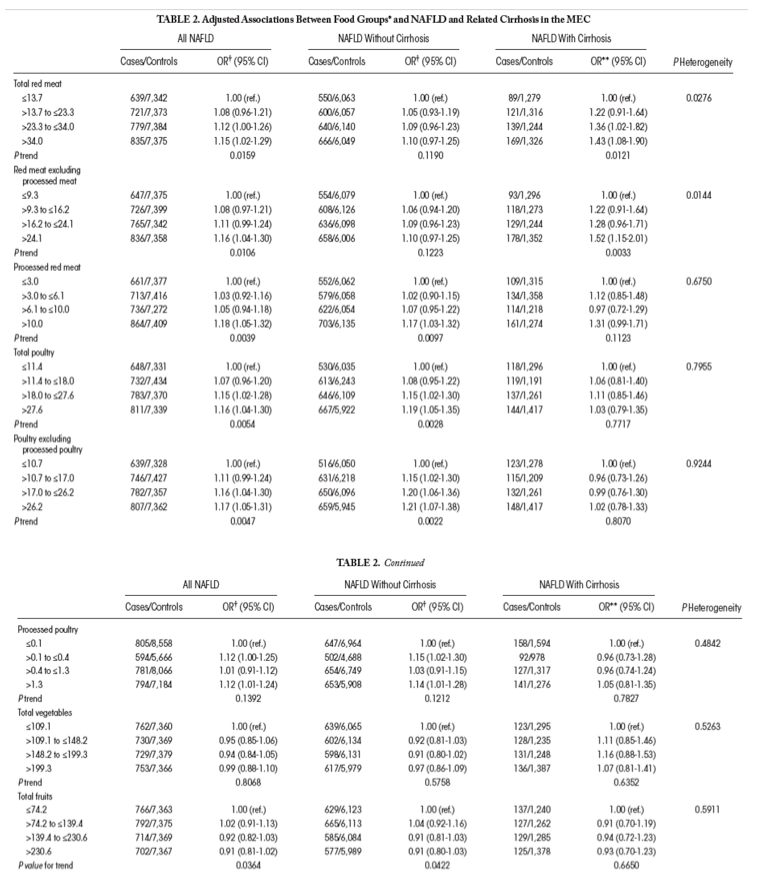
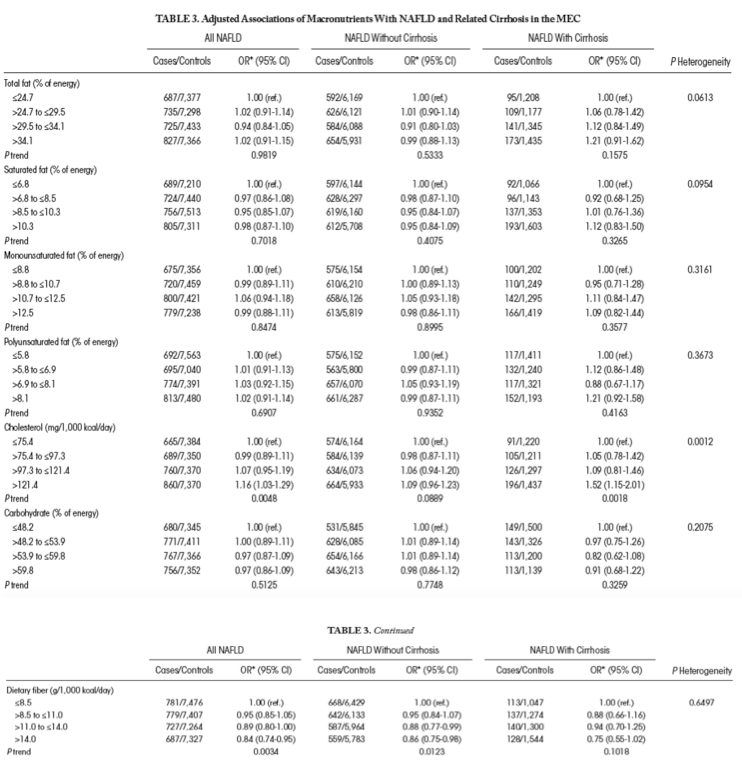
Discussion
In this large populationâ€based study of ethnically diverse populations in the United States, we assessed various dietary factors in relation to NAFLD and NAFLDâ€related cirrhosis. We found that higher intakes of red meat, processed red meat, poultry, and cholesterol are risk factors for NAFLD, while dietary fiber is a protective factor. Importantly, the associations were generally similar across a wide spectrum of racial/ethnic groups, supporting the external validity of the observed associations. Moreover, certain dietary risk factors (i.e., red meat and cholesterol) were associated with NAFLDâ€related cirrhosis.
Our findings agree with previous studies investigating the association of meat intake with NAFLD.8, 9, 14 In a crossâ€sectional study of 349 participants from a general population, protein from all types of meat was significantly associated with an increased risk for NAFLD (P for trend = 0.01 for increasing quartiles).14 More recently, a crossâ€sectional study of 789 participants by Zelberâ€Sagi et al. showed that high intakes of red meat and/or processed meat were associated with NAFLD; high intake of processed meat alone did not remain significantly associated with NAFLD after adjusting for physical activity and other factors.8 In that study, the association between processed meat was only observed with insulin resistance and not with NAFLD. The authors attributed these observations to the possibility of a relatively low consumption of processed meat in their study population. In the Rotterdam study of 3,882 (1,337 NAFLD cases) mostly elderly participants from Europe, a general association between total animal protein and NAFLD was observed only among overweight subjects.9 Our study confirmed and refined these associations; showing specific associations of red meat and processed red meat with both NAFLD and related cirrhosis, regardless of other risk factors including lifestyle characteristics.
Interestingly, we found that poultry intake was also associated with NAFLD risk. Most previous studies did not specifically examine poultry consumption as most focused on overall meat consumption or red and processed meat consumption. In a smaller case–control study of 280 Italians, Miele et al. demonstrated that a high consumption of white meat was associated with increased risk of NAFLD.22
The association between meat intake, particularly red and processed meat, and NAFLD risk is not unexpected. Both have shown associations with diabetes, cardiovascular diseases, insulin resistance, CLD, and HCC.23-25 Freedman et al. showed that red meat is associated with risk of CLD and HCC, both of which may lead to or emerge with cirrhosis progression.25 The harmful effect of red meat has been partially attributed to the formation of heterocyclic aromatic amines (HAAs) during less healthy cooking methods such as frying and barbecuing to a level of very well done. HAAs have been shown to increase oxidative stress, which is a key step in the pathophysiology of NASH and ultimately cirrhosis.26-28 Collectively, these findings highlight the possible harmful effects of red meat and their association with NAFLD. Indeed, the Mediterranean diet, which is low in red meat and processed red meat, was found to be beneficial in NAFLD, leading to decreased steatosis and improved insulin resistance.11, 29 In a recent prospective study of diet quality and NAFLD by genetic risk score, red meat was implicated as one of the driving components for the association between diet quality and changes in liver fat.12
In our study, we found an inverse association between total dietary fiber and NAFLD. Only few, smaller observational studies reported that patients with NAFLD consume fewer vegetables and less dietary fiber than controls.30, 31 Randomized intervention studies have shown that fiber intake improves liver enzymes and noninvasive NAFLD scores among participants with NAFLD.32, 33 We found a significant inverse trend between fruit intake and NAFLD, and a previous study showed that fiber from fruits has a favorable effect on liver enzymes among obese individuals.33 While it has been suggested that a highâ€fiber diet could have a preventive role in liver diseases, and indeed high fiber intake is one of the plausible molecular mechanisms for the beneficial effect of the Mediterranean diet in NAFLD,21, 34 more studies are warranted to confirm our findings and support this recommendation.
Although total fat and fat composition were not associated with NAFLD, cholesterol consumption was associated with NAFLD risk in our study. It is interesting to note that the association was mainly observed for NAFLD with cirrhosis. A prospective analysis using National Health and Nutrition Examination Survey data (5â€year followâ€up, 123 cases with cirrhosis among 9,221 participants) showed similar findings; while total fat consumption was not associated with the risk of cirrhosis, cholesterol consumption was associated with higher risk.35 Dietary cholesterol is suggested to be an important risk factor for the progression to hepatic inflammation in dietâ€induced NASH.36 However, the role of cholesterol and the severity of NAFLD have been established mostly in animal models and less consistently in human studies. A diet of normalâ€weight patients with NASH compared to ageâ€matched, genderâ€matched, and BMIâ€matched controls was richer in cholesterol37; and a similar finding was seen in the diet of normalâ€weight patients with NAFLD compared to patients with obesity and NAFLD.38 Previous epidemiological studies, however, did not demonstrate an association between cholesterol intake and NAFLD.9, 14 Min et al. showed that 3â€hydroxyâ€3â€methylâ€glutarylâ€coenzyme A reductase expression was correlated with free cholesterol, lowâ€density lipoprotein cholesterol, and histologic severity of NAFLD.39 Their data revealed that dysregulated cholesterol metabolism in human NAFLD may contribute to disease severity. In animal models, cholesterolâ€rich diets have led to oxidative stress and progression from NAFLD to NASH.40, 41 Others have shown that mitochondrial free cholesterol loading (but not fatty acids or triglycerides) leads to mice being sensitized to tumor necrosis factor–induced and Fasâ€induced steatohepatitis.42 Studies in mice have also shown that free cholesterol accumulates in hepatic stellate cells and that a highâ€cholesterol diet aggravates liver fibrosis.43, 44 Altogether, these studies support our finding of an association between dietary cholesterol and NAFLD severity.
There are several strengths to our study including the large sample size, populationâ€based design, inclusion of diverse and highâ€risk understudied populations, and detailed dietary and nutrient intake data with a wellâ€validated questionnaire, in addition to available information on potential confounders. We also showed that >99% of NAFLD cases with blood samples did not have underlying viral hepatitis based on serum testing.
Nevertheless, there were several limitations that should be noted. Bias in selfâ€reported diet is inevitable and may have led to some degree of nondifferential misclassification of exposure, which could have attenuated the observed associations. In addition, diet was assessed at baseline and may have changed during followâ€up, but in the subset of participants with repeated QFFQ in 2003â€2007 (∼58% participants with an average of 11.0 years between measurements), an analysis using averaged nutritional intake values yielded similar results for overall NAFLD and by cirrhosis status. The case identification was based on Medicare claims without imaging data; thus, participants with undiagnosed NAFLD might have been inadvertently included in the control group, which can lead to underestimation of the true associations. The prevalence of NAFLD in our study was also likely underestimated, but it was consistent with other epidemiological studies that did not use imaging data.45-47 In addition, NAFLD identification using CLD claims may have led to selection of cases with more severe disease. Inclusion of older Medicare participants (i.e., age 65 or older) limits the generalizability of our results to younger populations. It is also possible that medication use (e.g., metformin, statins) may modify the diet–NAFLD association; unfortunately, we did not collect this information at baseline, and thus we were unable to examine the drug’s possible modifying effects. Finally, while we adjusted for several important potential confounders including lifestyle factors in our analyses, as in any observational study, residual confounding cannot be excluded completely.
Dietary recommendations remain the first step and cornerstone of NAFLD/NASH treatment. Our findings suggest that diets low in meat and cholesterol and high in fiber may reduce the risk for NAFLD and for related advanced liver disease. Finally, our study calls for detailed nutrient documentation in future NASH trials, especially those with long followâ€up duration (phases 3 and 4) as diet may influence disease progression and study results.
| |
| |
| |
|
|
|